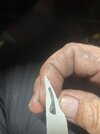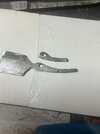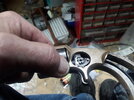In the thread "Drilling HSS" 1 I referenced that I was fabricating a new hand for the Marlin 1873 revolver. Here is a short clip of the issue:

 photos.app.goo.gl
photos.app.goo.gl
This occurs on every cylinder in exactly the same position. So I have ruled out the ratchet teeth as the cause of the problem. I have manipulated the hand manually and it just appears short. So this weekend I began fabricating a new replacement. I've abandoned using high speed Steel at the suggestion of another forum member. That suggestion was that the hand should probably be softer than the ratchet teeth. And I tend to agree.
I managed to post my photos with two different devices and the accounts aren't linked. I'm going to continue in the next post from my phone where the next set of pictures reside. These will entail the steps in the fabrication process.
New video by John M
 photos.app.goo.gl
photos.app.goo.gl
This occurs on every cylinder in exactly the same position. So I have ruled out the ratchet teeth as the cause of the problem. I have manipulated the hand manually and it just appears short. So this weekend I began fabricating a new replacement. I've abandoned using high speed Steel at the suggestion of another forum member. That suggestion was that the hand should probably be softer than the ratchet teeth. And I tend to agree.
I managed to post my photos with two different devices and the accounts aren't linked. I'm going to continue in the next post from my phone where the next set of pictures reside. These will entail the steps in the fabrication process.




